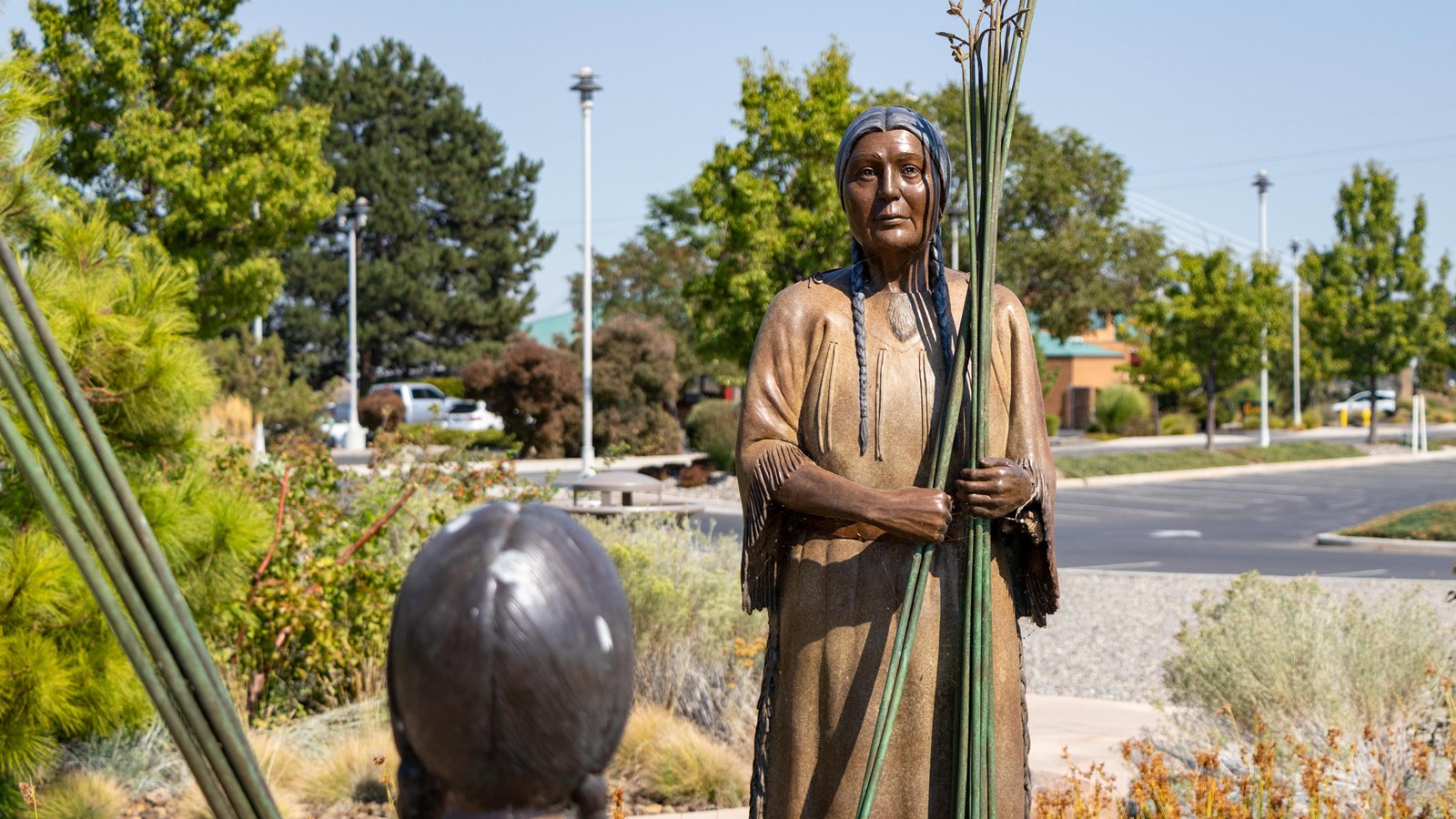Last updated: March 10, 2022
Place
The Gathering Place

NPS/BURGHART
Benches/Seating, Historical/Interpretive Information/Exhibits
The statues at the Gathering Place or Wiyákuktpa, share the Confederated Tribes of the Umatilla Indian Reservation’s customs and traditions of gathering tule reed around Ánwas, the area now known as Clover Island in Kennewick, Washington. In addition to the Umatilla, the Nez Perce, Wanapum, and Yakama tribes have called the Hanford area home since ancient times. This land provided everything the Native peoples needed to survive and thrive. They lived according to the seasons in an annual cycle of gathering, fishing, hunting, trading, and preparing for the next season. Elders taught the children the ways of their people. Today, tribal people continue to follow these traditions by hunting, gathering, and processing subsistence foods in a seasonal cycle.
Lewis and Clark arrived at the confluence the Snake and Columbia Rivers on October 16, 1805, where Sacajawea Historical State Park is today. They were immediately met by Yakama and Wanapum who sold them much needed food and gave them information about the area. The arrival of these explorers where a harbinger of the significant change white settlers would bring to the Pacific Northwest. Fur trappers followed the Lewis and Clark Expedition into the Pacific Northwest. Missionaries and white settlers followed the fur trappers.
In 1855, after many years of conflict between Native Americans, missionaries, and settlers, several thousand tribal members from present-day Idaho, Oregon, and Washington met in the Walla Walla Valley to discuss agreements between sovereign tribal nations and the United States. In less than a month, leaders from both sides signed three treaties that created the Nez Perce, Umatilla-Cayuse-Walla Walla, and Yakama reservations. These treaties were ratified in 1859 and became supreme law of the land. These treaties guarantee the Confederated Tribes of the Umatilla Reservation, Nez Perce, and Yakama nations legal status and their government-to-government relationship with the United States. These treaties remain in place today.
The treaties of the Walla Walla Council of 1855 also guaranteed Native American signatories access to resources such as salmon, game, and medicinal plants at their “usual and accustomed places,” retaining some of their traditional lifeways even though they lost million acres of land and billions of dollars in resources. The Wanapum people never fought white settlers and never signed a treaty with the US government. As a result, they did not retain federally recognized land rights.
Native Americans were again displaced from a portion of their traditional homelands with the arrival of the Manhattan Project in 1943. The Manhattan Project’s need for a large safety and security perimeter would further dispossess Native Americans when the federal government appropriated 670 square miles (1740 sq kilometers) of land for the Hanford Site. Tribes lost access to their “usual and accustomed places” for fishing, hunting, and gathering on the Hanford Site that were guaranteed to them in the treaties of 1855. Tribes continued to protect their fishing rights through lawsuits and protests that led to the restoration of many of their treaty guarantees in the late 1990s and early 2000s. Due to these efforts, the Confederated Tribes of the Umatilla Indian Reservation, Nez Perce, Wanapum, and Yakama nations are now partners in the Hanford Site’s cleanup process with a legally mandated role in determining the proper methods of protecting and enhancing water quality.
Continue Your Journey
The Gathering place was created in partnership by the Confederated Tribes of the Umatilla Indian Reservation, Tamástslikt Cultural Institute, and the Port of Kennewick. You may visit the Gathering Place to see Sculptor Rodd Ambroson’s bronze statues and read educational panels that tell the story of indigenous life in the past and the present.
To learn about the Tribes of the Columbia Plateau and important places in their lives, visit Nez Perce National Historical Park, Sacajawea Historical State Park, Tamástslikt Cultural Institute, Wanapum Heritage Center, and Yakama Nation Museum & Cultural Center.
